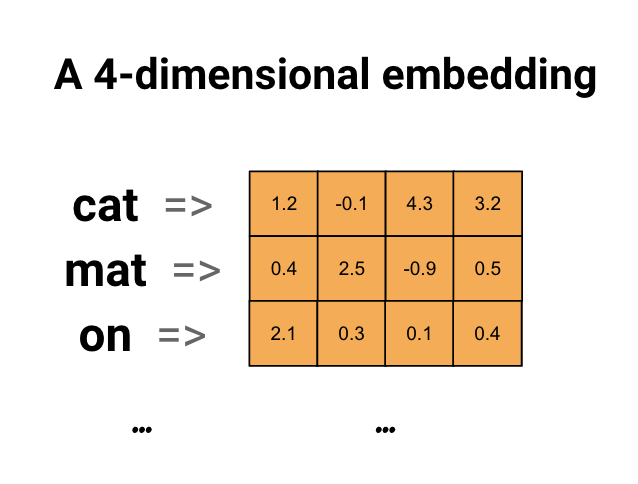Word embeddings
From the TensorFlow documentation word embeddings documentation
Word embeddings give us a way to use an efficient, dense representation in which similar words have a similar encoding.
Importantly, you do not have to specify this encoding by hand. An embedding is a dense vector of floating point values (the length of the vector is a parameter you specify).
Instead of specifying the values for the embedding manually, they are trainable parameters (weights learned by the model during training, in the same way a model learns weights for a dense layer).
It is common to see word embeddings that are 8-dimensional (for small datasets), up to 1024-dimensions when working with large datasets. A higher dimensional embedding can capture fine-grained relationships between words, but takes more data to learn.

Let us explore the word embedding with some examples. We will use spacy for demonstration.
import numpy as np
import spacy
from sklearn.metrics.pairwise import cosine_similarity
# Need to load the large model to get the vectors
nlp = spacy.load('en_core_web_lg')
nlp("queen").vector.shape
We find the word embedding of a single word queen and find that we have a vector with 1 row and 300 columns. Therefore a single word is converted to 300 numerical values.
We find the similarity between the words using cosine similarity
cosine_similarity([nlp("queen").vector],[nlp("king").vector])
0.725261
cosine_similarity([nlp("queen").vector],[nlp("mother").vector])
0.44720313
cosine_similarity([nlp("queen").vector],[nlp("princess").vector])
0.6578181
We observe that the similarity between queen and king is the highest , followed by princess and mother
We will see that how we can use the similarity between sentences
x1 = nlp("I am a software consultant").vector
x2 = nlp("Hey ,me data guy").vector
x3 = nlp("Hey ,me plumber").vector
x1.shape , x2.shape , x3.shape
((300,), (300,), (300,))
We find that the shape of the sentence vectors are also 1 x 300. The individual words also have shape 1 x 300 . But for a sentence , we average the vectors so as to get the shape also as 1 x 300.
cosine_similarity([nlp("x1").vector],[nlp("x2").vector])
0.7383951
cosine_similarity([nlp("x1").vector],[nlp("x3").vector])
0.64217263
We see that the similarity between the senctence with software consultant and data guy is higher than the sentence with software consultant and plumber